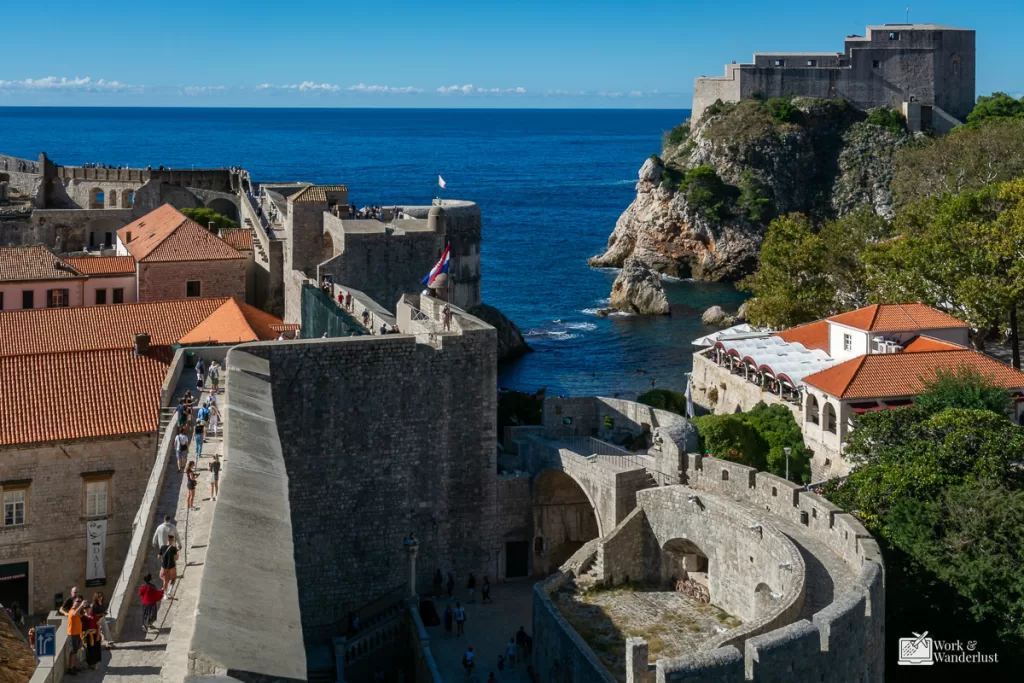The Croatia digital nomad visa is tailored for remote workers. It enables individuals from around the world to reside and work in Croatia for up to a year. Our article is not just a theoretical guide—it’s a practical roadmap.
It walks you through the Croatian digital nomad visa application process. And it will make your transition to the digital nomad lifestyle in Croatia as smooth as possible. It also provides essential information on extending your stay in this picturesque Mediterranean country.
We also outline the pros and cons of living in Croatia, as well as provide an estimated cost of living in the country. We give a brief overview of cities, highlighting their top attractions and activities. Whether you are a freelancer, entrepreneur, or remote employee, our comprehensive guide helps you consider and navigate the path to becoming a digital nomad in Croatia.
We use affiliate links throughout our site, recommending services and products that have served us well as digital nomads and travelers. If you make a purchase, we receive a bit of money. If you find our content helpful or inspiring, consider buying us a coffee or tea to support our work.
Croatia Digital Nomad Visa
Visa Requirement & How to Apply
We aim to provide a concise yet accurate overview of the Croatia digital nomad visa requirements and the steps involved. Please let us know if you notice any inaccuracies so we can correct them.
| Country: | Croatia |
| Currency: | Euro or EUR (€) |
| Visa Category: | Digital Nomad Visa Croatia (Digital Nomad Residency Permit) |
| Visa Length: | 1 year |
| Renewable Visa? | No. You can return to Croatia and apply for a second digital nomad permit six months after the expiry of your first permit. However, you may be able to switch to another type of permit, such as the “temporary residency for other purposes” permit, for up to an additional year without leaving the country, provided you remain outside the country for at least six months between permits. |
| Croatia Digital Nomad Visa Cost: | €190 for an out-of-the-country application or €87.60 for an in-country application. |
| Income Requirements: | €2,870 monthly income or an account balance of €34,440. |
| Tax Implications: | Tax-free on all foreign income. (Check your tax obligations with your home country.) |
| Dependents Allowed? | Yes. You can bring dependents. The monthly income or bank balance requirements increase by 10% to €3,157 or a balance of €37,884. |
| Application Location Options: | Apply from your home country, from overseas, or from within Croatia. You can enter Croatia on a tourist visa and submit your application before your tourist visa expires. You can remain in the country while the digital nomad permit is processed. |
Croatia Digital Nomad Visa Requirements
Important Note: Some documents may require official translation into Croatian.
- Authenticated copy of passport with a minimum of six months’ validity left
- Two passport photos
- A letter of intent explaining your purpose for residing in Croatia
Proof of remote work (e.g., work contract, pay stubs, statement from employer, or evidence of self-employment) - Bank statement showing the minimum income requirement for the past 6 months or showing the required balance in a lump sum
- Criminal record check (within the last six months) with apostille or notarization from your home country or the country you resided in the year before coming to Croatia
- Address in Croatia. You can provide a temporary address. You can then update the local MUP (Ministry of the Interior) of your permanent address later. Please note that permits are processed locally, and you must apply to the city where your intended address is located.
- Proof of medical insurance that covers you in Croatia (we use Genki health insurance)


We use Genki for our travel health insurance as budget digital nomads.
6 Croatia Digital Nomad Visa Application Steps
- Apply for an OBI number (also known as a personal ID number) online or in person at a Tax Administration office.
- Download and complete the Croatia digital nomad visa application form (PDF).
- Submit your application and all required documents to the online Croatia digital nomad visa portal.
- Wait for an email response. The processing time for the Croatia digital nomad visa varies and can be several months, but you can legally stay in the country during this period.
- When you receive a response, it may be to request additional documentation or to inform you that your permit has been approved.
- After approval, you must attend the designated MUP office to meet with an official to complete the process. Bring all paper copies of the forms and documents you submitted online. Additionally, please bring your passport and sufficient funds to cover the permit and resident card fees. As part of the completion process, you need a passport photo to apply for your resident ID card.
Pros and Cons of Being a Digital Nomad in Croatia
If you’re considering living and working in Croatia, we found that the pros easily outweigh the cons.
Benefits of Living in Croatia
- Relatively affordable cost of living compared to other EU countries
- Excellent and affordable private healthcare
- Reliable internet
- Cities are well-connected by public transportation
- Extensive coastline and numerous islands to visit
- A mild winter in most regions
- English is widely spoken
Disadvantages of Living in Croatia
- Bureaucracy is slow, and most processes are not digitized yet
- The coast gets very crowded in summer and is overrun by cruise ships
- Limited flight and train connections to other parts of Europe in comparison with other EU countries
Average Monthly Costs of Living in Croatia (USD)
| 1 Bedroom Apartment: | $580 to $800+ |
| Food: | $200 to $300+ per adult |
| Utilities: | $70 to $95+ |
| Data Plan: | $25 for a 10 GB data plan |
| Single Fare Public Transport: | $0.60 |
6 Top Cities in Croatia for Digital Nomads
- Dubrovnik: This city combines medieval charm with modern amenities. It is a beautiful coastal city with a mild climate.
- Pula: A smaller city that features rich Roman history and a relaxed vibe.
- Rijeka: A cultural hub with a vibrant arts scene. Its coastal location makes it ideal for exploration.
- Split: Blends ancient history with modern life. It has easy access to beaches and islands.
- Zadar: This city merges ancient and modern attractions. Its beautiful coastline and parks make it ideal for nature lovers.
- Zagreb: This is Croatia’s vibrant capital. It has reliable, high-speed internet and public transportation. It also boasts excellent bike lanes, access to natural spaces, and a thriving coffee and café culture.
4 Top Things To Do in Croatia

These are just a few of the activities you can do in Croatia. Additionally, you can easily visit neighboring countries, such as Slovenia and Italy.
- Plitvice National Park: This UNESCO World Heritage site features a network of 16 lakes and numerous waterfalls. Krka National Park is another fantastic option.
- Old Historic Towns: The Adriatic coastline is teeming with ancient cities boasting Roman architecture, the most famous of which is Dubrovnik, renowned for its iconic city walls. Be sure to visit the underappreciated region of Istria. You can experience the Roman Colosseum outside of Italy in Pula, and Motovun is a unique hilltop town.
- Islands: The archipelago comprises approximately 78 islands, offering opportunities to explore history, hike, kayak, and swim.
- Dinaric Alps: Trek through the karst mountain range, where you often have an incredible seaside view.
We’ve curated a few of the best-quality Croatia excursions available for sign-up through Viator. Book ahead with cancellation options.
Our Digital Nomad Visa in Croatia Experience
During the initial application process, we temporarily stayed in an Airbnb in Zagreb. We then secured a rental opportunity in Zagreb with a year-long rental agreement for our permanent address. Our landlord was very helpful with our visa application. We easily found translation services in Zagreb through a Google search.
We debated living on the coast in a city like Split. We had heard that the application process was quicker there and that there was less bureaucracy. However, the coast is known to be more expensive than inland cities and becomes very crowded during the summer. Also, some smaller seaside towns have weaker internet connections.
Looking back, we happily settled in Zagreb. It’s a very livable city, aligning with our preferences for a lower cost of living, stable high-speed internet, and a laid-back atmosphere. We enjoyed taking short trips to the coast during the off-season to avoid the busy crowds.
We ended up extending our stay for another year. We applied for temporary residency under “other purposes” through Croatia’s one-year pre-paid rent option. This extension involved more bureaucracy, but the extra year was well worth the effort!
The Croatia digital nomad visa process was much more manageable. But we still recommend staying for two years if you can afford it.
Digital Nomad Visa for Croatia Summary
Croatia has stunning landscapes, a welcoming culture, and a relaxed environment. It’s an ideal destination for digital nomads seeking a unique and enriching experience.
By following the steps outlined in our guide, you can successfully apply for your Croatian digital nomad visa. You may need to navigate some bureaucratic hurdles. However, in the end, it will be worth it to be able to live and work in this beautiful country.
Buy travel health insurance for your Croatia digital nomad visa application.
Croatia Digital Nomad Visa FAQs
These are the most frequently asked questions about the Croatian digital nomad visa.
Does Croatia offer a digital nomad visa?
Yes. Croatia offers a digital nomad visa that enables remote workers to reside and work in the country for up to one year.
Do digital nomads pay tax in Croatia?
Digital nomads are exempt from paying income tax in Croatia if their income is from outside the country.
What is the approval rate for the Croatia digital nomad visa?
The approval rate for the Croatia digital nomad visa is generally high. If all requirements are met, most applications are approved.
What is the cost of living in Croatia for digital nomads?
The cost of living in Croatia as a digital nomad, including rent, typically ranges around €1,100 ($1,200) per month on average, depending on lifestyle and location.

